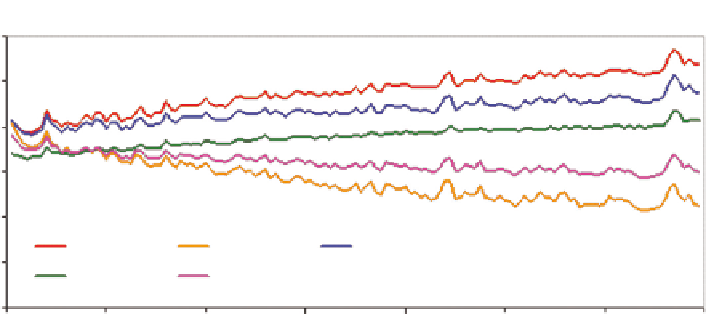Geoscience Reference
In-Depth Information
12
10
8
6
4
Baseline
Meadows
Fertilizer
Deposition
2
Combined
0
1960
1980
2000
2020
2040
2060
2080
2100
Year
Figure 10.3
The effects of climate change, simulated by the INCA-N model, in the river
Kennet for 1960-2100, together with the effects of various adaptation strategies. These
were 'fertilizer', reduce N fertilizer input by 50%; 'deposition', reduce atmospheric N
deposition by 50%; 'meadows', increase denitrification fourfold by constructing water
meadows; 'combined', apply all three strategies but at half the rate.
These reductions also need to be seen in context. Inorganic nitrogen
concentrations in rivers draining pristine catchments are often very low (<0.2 mg
N l
−1
; e.g. Perakis & Hedin 2002). The Kennet catchment has been at least partly
agricultural land since the Bronze Age, and hence, it is likely to be a long time
since conditions were uninfluenced by humans. However, the modelling estimates
for the Lambourn (the major tributary of the Kennet) suggest that even in the
1920s, before the widespread use of artificial N fertilizers in the catchment,
stream nitrate concentrations were only about a ninth of those currently observed.
From Fig. 10.3, this would imply about 1 mg N l
−1
for a 1920s nitrate concentration
in the Kennet. Therefore, even the most effective mitigation option is unlikely to
cause a return to pristine conditions.
Dynamic models other than the INCA models have been used and developed in
the Euro-limpacs project. Andersen
et al
. (2006) analysed climate change impacts
on hydrology and nutrient dynamics in the 113.5 km
2
Gjern River Basin in
Denmark with the NAM-MIKE11-TRANS model chain and with regional climate
model HIRHAM predictions used for meteorological prediction. HIRHAM
predicted a non-significant increase in mean annual precipitation of 47 mm (5%)
and a significant (
p
< 0.001) increase in mean annual air temperature of 3.2 °C
(43%) between the control (1961-90) and the scenario (2071-2100) periods. The
precipitation-run-off model (NAM) used these data to forecast that the mean
annual run-off from the river basin would increase by 27 mm (7.5%,
p
< 0.05)
between the control and the scenario periods. Changes in the extremes were larger:
run-off during the wettest year in the 30-year period increased by 58 mm (12.3%).
The most dramatic change in hydrological regime was modelled for the headwater
Gelbæk stream draining an 11.1 km
2
loamy catchment. Large (40%-70%) and
significant (
p
< 0.05) reductions in run-off during late summer (August to October)




























Search WWH ::

Custom Search